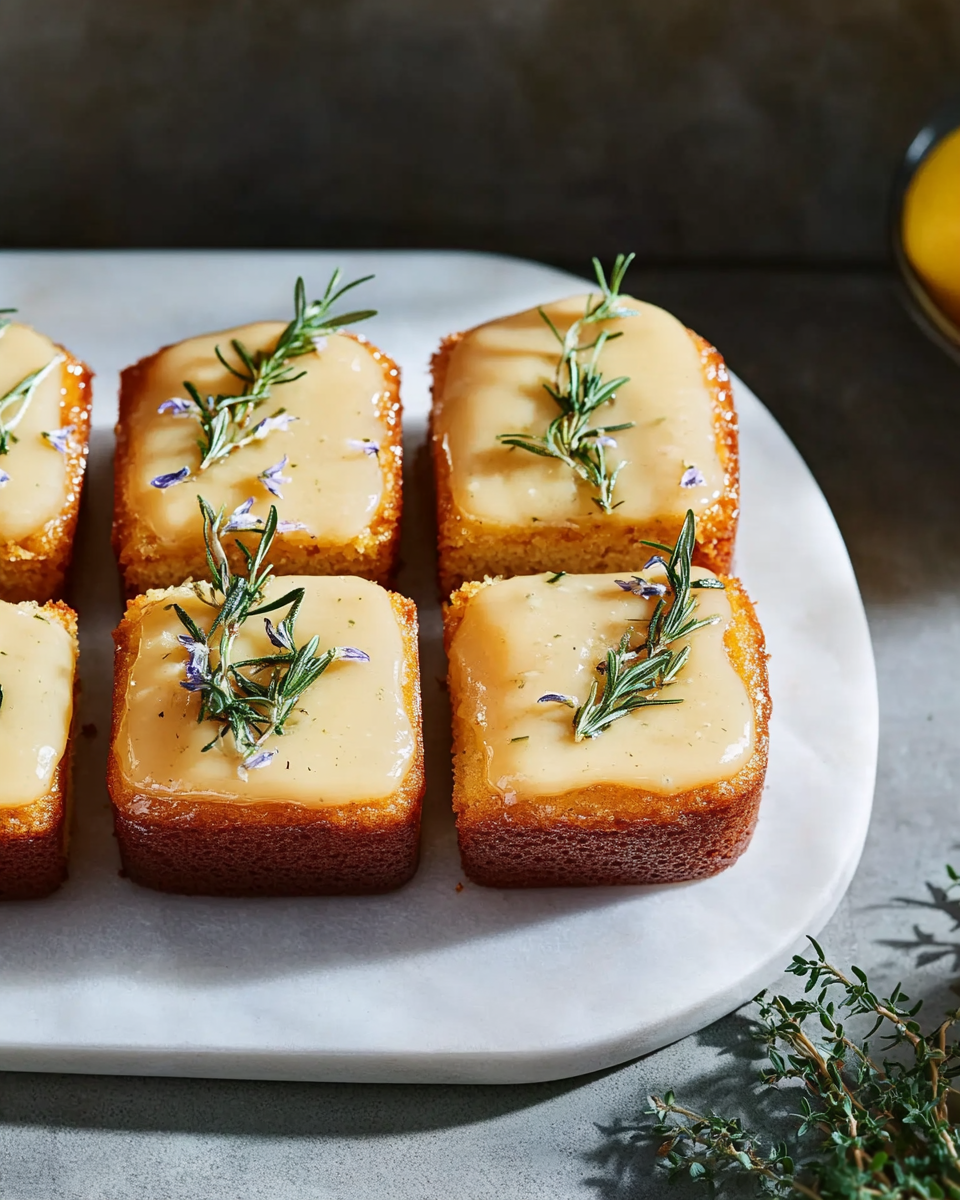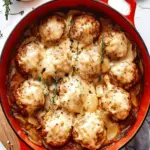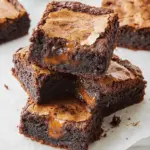This Rosemary Syrup Cake with Mead Cream is a delightful dessert that combines the earthy, fragrant notes of rosemary with a moist, sweet cake soaked in a simple rosemary-infused syrup. The rich and slightly boozy mead cream adds a luxurious touch, making it perfect for a relaxed weekend baking project or a special occasion. As a bonus, there’s also a refreshing Lemon Syrup Cake recipe that’s bright and zesty, ideal for those who love citrus flavors.
Full Recipe:
Ingredients
For the Cake:
-
1 ¾ cups all-purpose flour
-
1 ½ teaspoons baking powder
-
¼ teaspoon salt
-
1 tablespoon fresh rosemary, finely chopped
-
1 cup granulated sugar
-
¾ cup unsalted butter, softened
-
3 large eggs
-
½ cup whole milk
-
1 teaspoon vanilla extract
For the Rosemary Syrup:
-
1 cup water
-
1 cup granulated sugar
-
2 tablespoons fresh rosemary sprigs
For the Mead Cream:
-
1 cup heavy cream
-
3 tablespoons mead (honey wine)
-
2 tablespoons powdered sugar
Directions
-
Preheat oven to 350°F (175°C). Grease and flour a loaf pan or cake tin.
-
In a medium bowl, whisk together flour, baking powder, salt, and chopped rosemary.
-
In a large bowl, beat the butter and sugar until light and fluffy. Add eggs one at a time, beating well after each addition. Stir in vanilla extract.
-
Gradually add the dry ingredients alternately with milk, beginning and ending with the dry ingredients. Mix until just combined.
-
Pour batter into the prepared pan and bake for 45–50 minutes or until a toothpick inserted into the center comes out clean.
-
While the cake bakes, combine water, sugar, and rosemary sprigs in a saucepan. Bring to a boil, then simmer for 5–7 minutes. Remove from heat and let cool slightly. Remove rosemary sprigs.
-
When the cake is done, remove it from the oven and immediately poke holes in it using a skewer or fork. Slowly pour the warm rosemary syrup over the cake, allowing it to soak in. Let the cake cool completely.
-
In a chilled bowl, whip the heavy cream until soft peaks form. Gradually add powdered sugar and mead, continuing to whip until stiff peaks form.
-
Serve slices of the syrup-soaked cake with a generous dollop of mead cream.
Lemon Syrup Cake
Ingredients
-
1 ½ cups all-purpose flour
-
1 ½ teaspoons baking powder
-
¼ teaspoon salt
-
¾ cup unsalted butter, softened
-
1 cup granulated sugar
-
3 large eggs
-
½ cup buttermilk
-
Zest of 2 lemons
-
2 tablespoons fresh lemon juice
For the Lemon Syrup:
-
½ cup water
-
½ cup granulated sugar
-
2 tablespoons fresh lemon juice
Directions
-
Preheat oven to 350°F (175°C). Grease and flour a loaf pan.
-
In a medium bowl, whisk together flour, baking powder, and salt.
-
In a large bowl, cream butter and sugar until fluffy. Add eggs one at a time, beating well after each. Stir in lemon zest and juice.
-
Alternate adding dry ingredients and buttermilk, beginning and ending with dry ingredients. Mix just until combined.
-
Pour batter into pan and bake 40–45 minutes, or until a toothpick comes out clean.
-
For the syrup, combine water, sugar, and lemon juice in a saucepan. Heat until sugar dissolves. Remove from heat.
-
While cake is warm, poke holes and pour syrup over it. Let cake cool completely.
-
Serve plain or with whipped cream or fresh berries.
Nutrients (Estimate per serving for Rosemary Syrup Cake with Mead Cream)
-
Calories: 350 kcal
-
Carbohydrates: 45 g
-
Protein: 4 g
-
Fat: 15 g
-
Saturated Fat: 9 g
-
Sugar: 30 g
The Allure of Rosemary in Baking
Rosemary, a fragrant herb known for its piney, slightly peppery aroma, is more commonly associated with savory dishes. However, its use in baking brings an exciting dimension that marries well with sweet ingredients. When finely chopped and incorporated into the cake batter, rosemary infuses the cake with subtle earthy notes, providing complexity that contrasts nicely with the sugar and butter.
The rosemary syrup further intensifies this herbaceous quality by allowing the flavors to permeate the cake after baking, keeping the crumb moist and flavorful. This method of soaking the cake with syrup is reminiscent of classic Mediterranean and Middle Eastern desserts, where syrups infused with herbs or citrus are often used to add moisture and fragrance.
This combination of rosemary and syrup adds a refined twist to the traditional loaf cake, making it a standout option for those who appreciate nuanced flavors.
Mead Cream: A Luxurious Complement
Mead, often described as honey wine, brings its own unique profile to the dessert. Mead’s natural sweetness and floral notes complement the rosemary cake without adding heaviness. Whipped into cream along with powdered sugar, it becomes a light yet flavorful topping that enhances the cake’s moist crumb and herbal character.
Using mead in the cream rather than the cake itself ensures that its delicate flavors remain prominent and that the alcohol does not interfere with the cake’s texture. This whipped topping can be adjusted in sweetness and alcohol strength to suit personal preferences, offering flexibility.
Mead cream not only elevates the flavor but also adds an elegant touch to the presentation, transforming a simple cake into a gourmet dessert.
Texture and Flavor Harmony
The cake itself is moist and tender, thanks to the balance of butter, eggs, and milk in the batter. The infusion of rosemary within the crumb adds aromatic layers without overwhelming the palate. When soaked with the warm rosemary syrup, the cake becomes beautifully saturated, creating a melt-in-the-mouth sensation with every bite.
The contrast between the moist cake and the airy, whipped mead cream creates a delightful textural interplay. The syrup’s sweetness and the cream’s richness complement the herbal undertones, making each bite a well-rounded experience. The cake’s crumb is sturdy enough to hold the syrup without becoming soggy, a testament to the recipe’s careful balance of ingredients and technique.
Versatility and Occasions
Rosemary Syrup Cake with Mead Cream is versatile enough for many occasions. It’s ideal for afternoon tea or a casual dessert after a family meal but sophisticated enough for holiday gatherings, birthdays, or dinner parties. The herbal notes make it a wonderful choice for spring or summer menus when fresh herbs are abundant, but the comforting syrup-soaked nature suits cooler months as well.
Additionally, the recipe invites creativity. The cake can be paired with fresh berries or a drizzle of honey for extra flair. The mead cream can be whipped with a touch of vanilla or lemon zest to complement different flavor profiles. For a non-alcoholic version, honey or a floral syrup can substitute for mead in the cream, preserving the dessert’s luxurious texture and sweetness.
The Bright Alternative: Lemon Syrup Cake
Complementing the rosemary cake is the Lemon Syrup Cake, a vibrant, citrus-forward dessert that offers a different kind of freshness. This cake is ideal for those who prefer bright, zesty flavors over herbal notes. The use of lemon zest and juice in both the batter and syrup ensures the citrus flavor shines through in every bite.
Like the rosemary cake, it features a moist crumb that is soaked with a simple syrup, this time infused with lemon juice to add tang and sweetness. This cake pairs wonderfully with whipped cream or fresh berries, making it a light and refreshing option for warm-weather desserts or anytime a palate cleanser is desired.
Both cakes highlight the power of syrup-soaked desserts to elevate simple ingredients into memorable experiences, showcasing how syrups infused with herbs or citrus can transform texture and flavor.
Nutritional Insights
While both cakes are indulgent treats, they also provide nutritional value through wholesome ingredients like eggs, butter, and milk. The Rosemary Syrup Cake with Mead Cream contains moderate amounts of calories, fats, and sugars typical of syrup-soaked cakes, but its richness makes it suitable for enjoying in smaller portions as a satisfying dessert.
Eggs and butter contribute protein and fats essential for satiety, while the rosemary adds trace antioxidants and subtle nutrients. The mead cream, while adding richness, also imparts a touch of alcohol, so moderation is advised depending on the occasion.
The Lemon Syrup Cake is lighter on fats but similarly sweet, offering a fresher profile with the benefits of vitamin C from lemon juice and zest. Both recipes demonstrate how balanced desserts can be both pleasurable and sophisticated.
Baking Tips for Success
Key to these recipes is the proper preparation and baking of the cakes to achieve the ideal texture. Overmixing the batter can lead to a dense cake, so gentle folding and alternating wet and dry ingredients help keep the crumb tender.
Baking times may vary depending on oven calibration and pan size, so testing doneness with a toothpick is recommended. The syrup should be poured while the cake is still warm to ensure maximum absorption, infusing moisture and flavor throughout.
For the mead cream, chilling the bowl and beaters before whipping is essential for achieving stiff peaks and a smooth texture. Gradually adding the mead and powdered sugar while whipping prevents deflation and ensures even incorporation.
Conclusion
Rosemary Syrup Cake with Mead Cream is a beautifully balanced dessert that combines aromatic herbs, moist cake, and a rich, boozy cream to create an unforgettable treat. It’s a celebration of sophisticated flavors and textures that appeals to those who enjoy both traditional baking and innovative culinary twists. The accompanying Lemon Syrup Cake offers a bright, zesty alternative, perfect for lovers of citrus and fresh flavors.
Both cakes showcase the transformative power of syrup soaking to enhance moisture and flavor, making these recipes excellent choices for bakers seeking to impress with minimal complexity. Their adaptability, elegance, and depth of flavor ensure they will become favorites for special occasions or casual indulgences alike.
Including these recipes on your website will provide readers with creative dessert options that highlight seasonal ingredients, offer culinary inspiration, and invite the joy of baking with herbs and citrus. They perfectly embody the art of turning simple cakes into gourmet experiences, promising delight in every bite.






